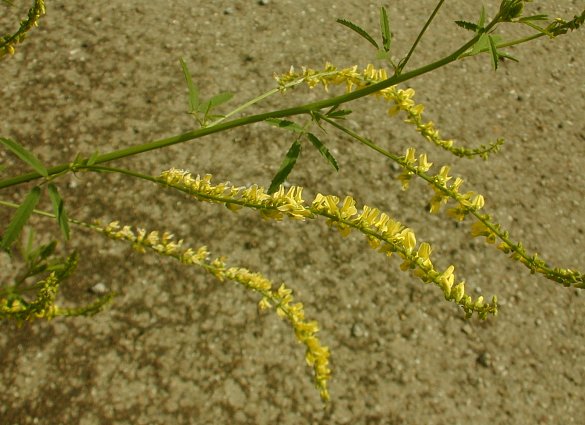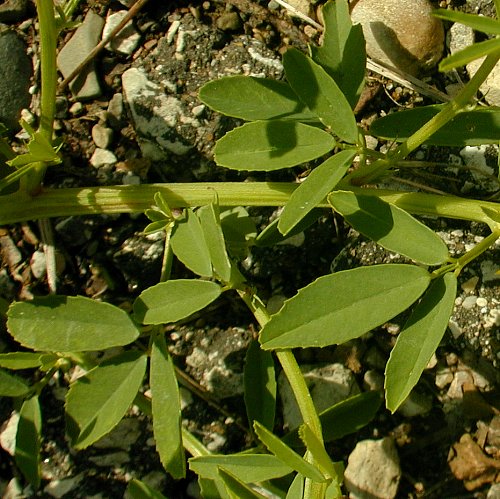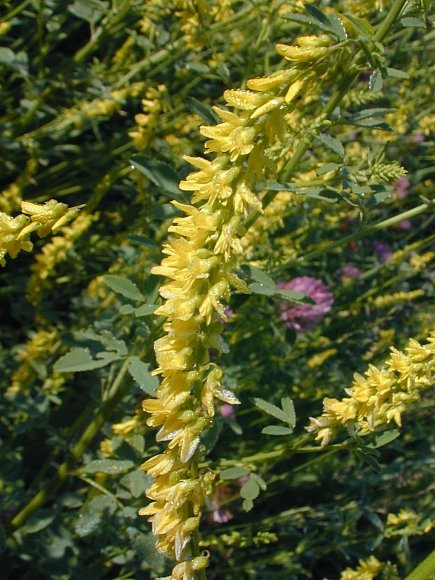Description: This annual or biennial plant is 2-7' tall. Larger plants branch frequently and are somewhat bushy in appearance, while shorter plants are less branched and rather lanky. The stems are usually more or less erect, although sometimes they sprawl across the ground. They are glabrous, furrowed, and angular; sometimes the lower stems are ribbed light red. The alternate compound leaves are trifoliate and hairless. Each leaflet is about ¾" long and ¼" across; it is oblong, oblanceolate, or obovate in shape, and dentate along the middle or upper margin. The terminal leaflet has a short petiolule (stalk at its base), while the lateral leaflets are nearly sessile. The petiole of each compound leaf is about ½" long; there are a pair of small linear stipules at its base. Spike-like racemes of yellow flowers are abundantly produced from the axils of the middle to upper leaves, while the upper stems eventually terminate in such racemes. Each raceme is up to 6" long and has dozens of flowers. These flowers are loosely arranged along the raceme and somewhat drooping. They may occur along one or two sides of the raceme, or in whorls.

Each
flower is about 1/3" (8 mm.) long and it has a tendency to droop
downward from the
raceme, although curving upward toward its tip. The corolla has 5
yellow petals and is rather slender, consisting of a standard, keel,
and two side petals. The tubular calyx is light green and has 5 pointed
teeth. The blooming period can occur from late spring to early fall,
peaking during early to mid-summer; a colony of plants will bloom for
about 2 months. There is a mild floral fragrance. Each flower is
replaced by a small seedpod with a beak that is flattened and contains
1-2 seeds. There are usually transverse ridges on each side that are
somewhat curved. The tannish yellow seeds are somewhat flattened and
ovoid-reniform in shape. Yellow Sweet Clover spreads by reseeding
itself, and it often forms colonies at favorable sites. The sweet
hay-like aroma of the foliage is caused by coumarin.
Cultivation:
The preference is full or partial sun, moist to slightly dry
conditions, and a somewhat heavy clay-loam soil. The mature size of
this plant is highly variable, depending on moisture availability and
the fertility of the soil. Its adds nitrogen to the soil by forming a
symbiotic association with rhizobium bacteria.

Range
& Habitat:
The non-native Yellow Sweet Clover is a common plant that occurs in all
counties of
Illinois (see Distribution
Map). It was introduced into the United States from Eurasia
as a forage crop and a green manure to replenish old fields. Habitats
include fallow fields, vacant lots, areas along railroads and
roadsides, black soil and clay prairies, weedy meadows, and waste
areas. Disturbed areas are preferred, although this species is
sufficiently aggressive to invade prairie remnants, where it often
becomes a nuisance.
Faunal Associations:
The nectar of the flowers attracts many kinds of insects, including
long-tongued bees, short-tongued bees, wasps, and flies. Less common
visitors include butterflies, skippers, beetles, and plant bugs. Yellow
Sweet Clover is a preferred nectar plant for honeybees. Sometimes bees
collect pollen as well. The caterpillars of various Blue and Sulfur
butterflies eat the foliage, flowers, or buds, including Hemiargus
isola (Reakirt's Blue). The caterpillars of the moth Walshia
miscecolorella (Sweet Clover Borer Moth) bore into the stems
and roots. The seeds of Melilotus spp. (Sweet
Clovers) are eaten by upland gamebirds to a limited extent, while the
green foliage is readily eaten by various mammalian herbivores,
including rabbits (young plants), groundhogs, deer, and livestock.
However, improperly cured forage from Sweet Clovers can be mildly toxic
to livestock.

Photographic
Location:
A vacant lot in Urbana, Illinois, where a gas station once existed, and
along a railroad of the same city.
Comments:
This is a tall lanky plant that sways back and forth in the wind and is
difficult to photograph. Yellow Sweet Clover is quite similar to Melilotus
alba (White Sweet Clover), which is another weedy species
that has been introduced from Eurasia for agricultural purposes. This
latter species has white flowers, greyish green foliage, and its
slightly reticulated seedpods lack conspicuous transverse ridges.
Otherwise, these two species are nearly identical. As a matter of fact,
some authorities regard Yellow Sweet Clover and White Sweet Clover as
different varieties of the same species. In my experience, Yellow Sweet
Clover begins to bloom about 2-3 weeks earlier than White Sweet Clover,
and it is more often found at sites that are moist and fertile.